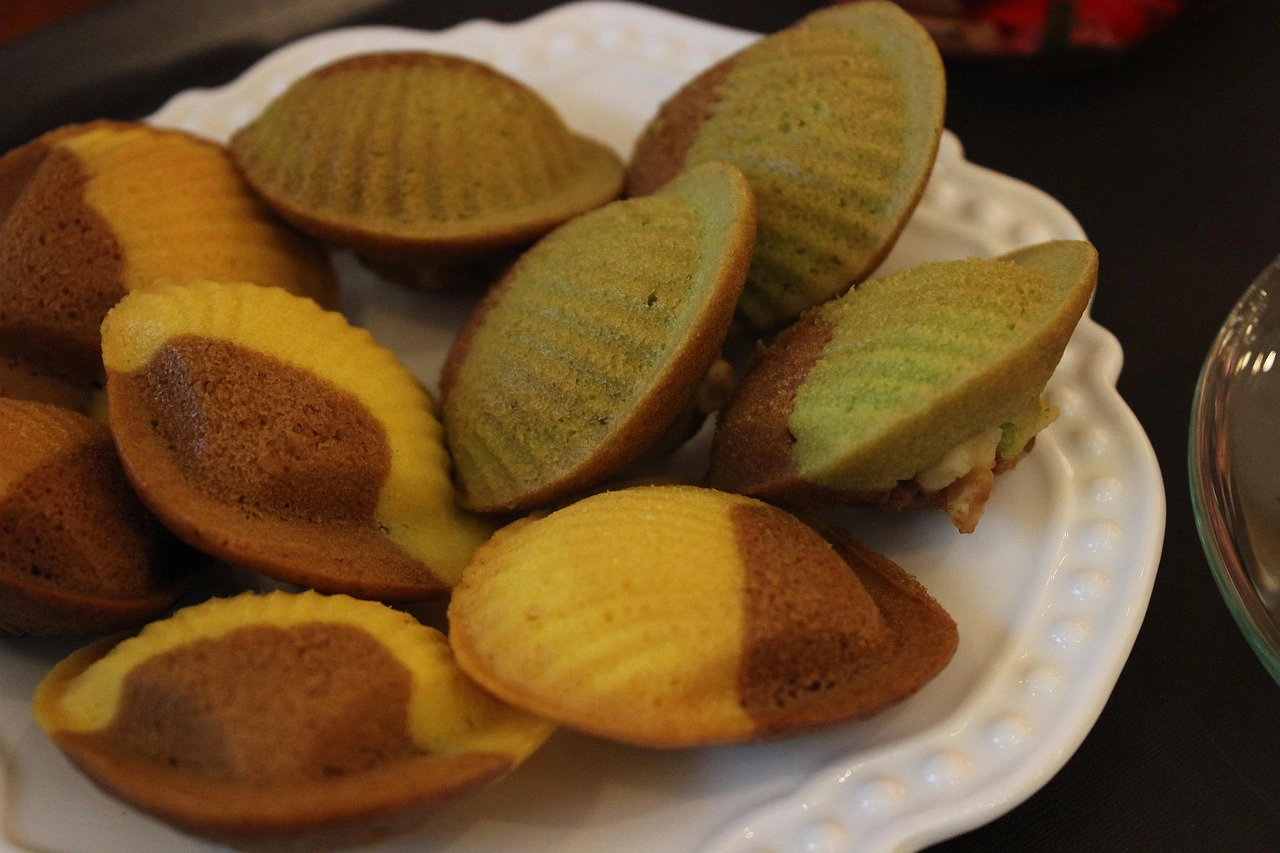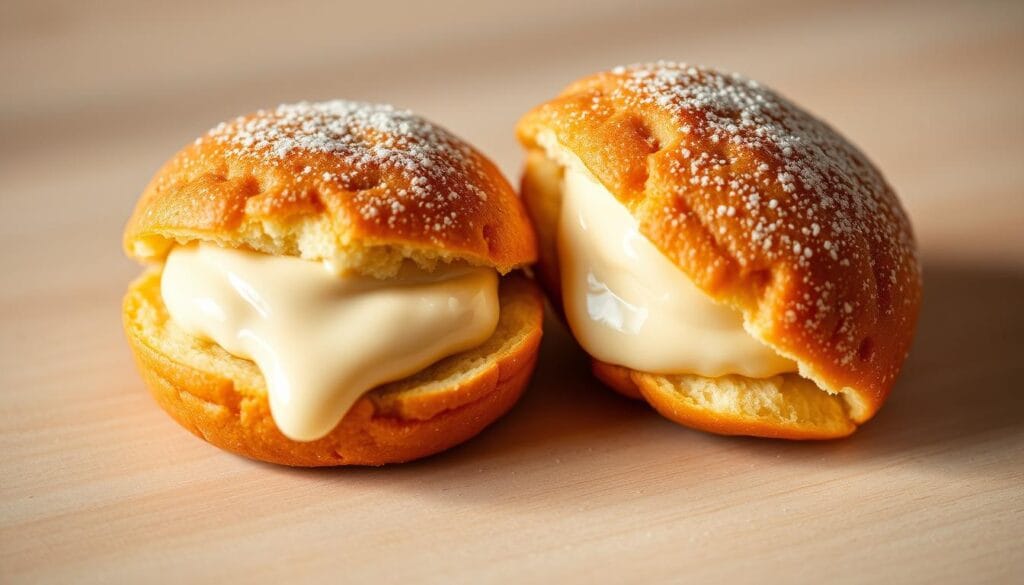Delightful Madeleine Cookies Using Cream: A Classic Recipe

There’s something magical about the first bite of a warm madeleine cookie. The shell-shaped sponge cake crumbles softly, melting into a buttery, creamy sweetness. It feels like a hug from a Parisian café. For years, I’ve admired these tiny treats—delicate yet rich, humble yet iconic.
Now, you can bring that same joy into your kitchen with this madeleine cookies with cream recipe. Madeleine cookies with cream aren’t just a treat; they’re a gateway to French patisserie, simplified for home bakers.
These petite cakes, born in France, transform basic ingredients into something extraordinary. The secret? Cream elevates their lightness, adding moisture and depth without heaviness. Whether you’re pairing them with afternoon tea or experimenting with chocolate or citrus twists, this guide breaks down every step—from whisking batter to perfecting that signature hump. Let’s turn tradition into your next kitchen triumph.
Table of Contents
The Delicate French Classic: Introduction to Madeleines
Madeleines are more than just a sweet treat—they’re a taste of history wrapped in buttery goodness. Born in 18th-century Lorraine, these small cakes became famous through tales of court kitchens and timeless recipes. Today, modern bakers add cream to the mix, blending tradition with a creamy twist that enhances their signature texture.
What Makes Madeleines Special
- Historical Charm: Their name honors Madeleine Paulmier, a chef who created them for the Duke of Lorraine.
- Texture Balance: A tender crumb contrasts with a golden, crackled crust.
- Flavor Simplicity: Vanilla and lemon zest highlight their buttery foundation.
The Signature Shell Shape and Texture
Every madeleine’s shell-shaped pan molds the dough into its iconic form. The pan’s grooves help create the telltale hump that rises during baking. This shape isn’t just for show—it traps air pockets, giving each bite a light, airy feel.
Why Cream Enhances Traditional Madeleines
Adding cream to the batter boosts moisture without making the cakes dense. The liquid deepens the flavor, making each madeline baked with cream taste richer while keeping the classic lightness. This tweak keeps them tender and moist even hours after baking.
The Rich History of Madeleine Cookies
Madeleine cookies come from 18th-century France, specifically from Commercy. A kitchen maid named Madeleine Paulmier made them for a royal feast. The King of Poland, Stanislas Leszczyński, loved them so much he named them after her. “This humble treat became a symbol of French culinary artistry,” says food historian Élodie Dubois.
“The madeleine recalled to me, as I write this, the ineffable joys of childhood.” – Marcel Proust, In Search of Lost Time
Over time, madeleines became loved worldwide. In the 1700s, Maria Leszczyńska, the King’s daughter, brought them to Versailles. By the 1900s, Commercy’s train station sold them to travelers, making them a French favorite.
| Year | Event | Legacy |
|---|---|---|
| 1730 | First recorded recipe in Commercy | Birth of the classic recipe |
| 1740 | Featured at Versailles court | Royal endorsement |
| 1913 | Proust’s literary mention | Cultural immortality |
| 1925 | Commercial packaging begins | Mass production starts |
Today, madeleine cookies are still loved for their buttery taste and unique shape. They are a mix of old traditions and new flavors. Enjoyed on their own or with cream, they bring history to life in every bite.
Essential Equipment for Baking Perfect Madeleines
Every baker knows the right tools make all the difference. To master the signature shell shape and texture of madeleine cookies, specific equipment ensures your madeleine baked results shine.
Choosing the Right Madeleine Pan
A quality pan is non-negotiable. Opt for a madeleine mold with shallow, ribbed cavities. Compare options:
| Type | Pros | Cons |
|---|---|---|
| Metal Pans | Heat distribution for even baking | May require more butter/oil for non-stick |
| Silicone Molds | Flexible for easy removal | Slower heat conduction |
Other Baking Tools You’ll Need
Prepare these essentials:
- Saucepan for melting butter
- Stand mixer (or hand mixer) with whisk attachment
- Fine mesh sieve for dry ingredients
- Pastry brush for greasing molds
- Cooling rack to prevent sogginess
Alternatives If You Don’t Have a Madeleine Mold
Don’t panic if you lack a dedicated pan. Try these substitutes:
- Mini muffin tins (for smaller versions)
- Small ramekins (for irregular shapes)
- Line standard muffin pans with silicone cups
Pro tip: Chilling the pan before baking enhances the classic hump formation.
With these tools, you’re ready to shape, mix, and bake madeleine cookies that rival patisserie quality. Prioritize quality pans but don’t let lack of specialty gear stop you—creativity in substitutions works wonders.
Ingredients for a Madeleine Cookies Recipe Using Cream
Every ingredient in your madeleine cookies with cream recipe is key to the French treat’s soft crumb and rich flavor. Let’s explore what makes the batter special, starting with cream.

The Role of Cream in Your Madeleines
Heavy cream is more than just an extra ingredient—it’s the secret to keeping them moist. Unlike traditional madeleine cookie recipe methods, cream adds a velvety texture. It prevents dryness and keeps the cookies soft for days. Use ¼ cup for that signature tenderness.
Flour, Sugar, and Leavening Agents
- All-purpose flour: 1 1/4 cups to hold the structure without overwhelming the batter.
- Sugar: 1 cup granulated sugar dissolves into the eggs, creating a light base.
- Baking powder: Just ½ tsp to lift the batter without over-rising.
Flavor Enhancers: Vanilla, Lemon Zest and More
Eggs (2 large) and melted butter (½ cup unsalted) anchor the recipe. Add 1 tsp vanilla extract for warmth and lemon zest for brightness. Salt (¼ tsp) balances sweetness without tasting salty.
Ingredient Substitutions and Alternatives
| Original | Substitute |
|---|---|
| Heavy cream | Cashew cream or oat milk for dairy-free |
| All-purpose flour | Gluten-free 1:1 flour blend |
| Sugar | Coconut sugar or maple syrup (reduce liquid if using) |
Try citrus zests like orange or bergamot to make this madeleine cookies with cream recipe your own.
Step-by-Step Madeleine Baking Method
Learn to make creamy madeleines cookies with this simple method. Each step helps achieve the signature shell shape and moist texture.
- Prepare ingredients: Let eggs and cream come to room temperature. Zest lemons and measure all dry ingredients.
- Whisk eggs and sugar in a bowl until pale yellow and frothy. This creates air for a light texture.
- Mix in vanilla and lemon zest. Gently fold in sifted flour and baking powder to avoid overmixing.
- Add melted butter and cream until batter is smooth. Overmixing here can make madeleines dense.
- Chill batter for 1 hour. This resting time strengthens the hump and enhances flavor.
- Preheat oven to 375°F (190°C). Grease molds with butter, then dust with flour for easy release.
- Fill molds ¾ full using a piping bag or zipped plastic bag. Overfilling causes spreading.
- Bake 10-12 minutes until edges are golden and a toothpick comes out clean.
- Remove from pan immediately to cool on a rack. Letting them rest too long in the mold can cause them to lose their shape.
- Room-temperature ingredients mix better for even texture.
- Chilling batter ensures a pronounced hump and tender crumb.
- Nonstick molds are essential for perfect shell patterns.
- Don’t skip sifting flour—it prevents lumps.
Mastering the Signature Madeleine Hump
The iconic hump of madeleine cookies with cream recipe defines their charm. This rise isn’t just a fluke—it’s science in action. Understanding the process ensures your madeline baked creations stand tall.

The Science Behind the Bump
Batter temperature and oven heat collide to create the hump. Cold batter contracts when meeting a hot oven, trapping air bubbles from ingredients like baking powder. This expansion lifts the center, forming the classic dome. Overmixing deflates these bubbles, so gentle folding is key.
Chilling Techniques for Perfect Results
- Chill batter for 20–30 minutes (or longer) to stabilize its structure.
- Preheat the oven to 375°F (190°C) to ensure rapid initial heat exposure.
- Fill molds ¾ full—too much batter prevents rising, too little flattens the result.
Common Mistakes That Flatten Your Madeleines
- Skipping chilling: Warm batter rises unevenly, losing the hump.
- Underheating pans: A cold pan slows the reaction, preventing lift.
- Overfilling molds: Excess batter spills over edges, blocking upward expansion.
Master these steps, and your homemade madeline baked cookies will showcase that sought-after peak every time.
Delicious Variations on Classic Madeline Cookies
Once you’ve mastered the madeleine cookie recipe, try these creative twists. They keep the classic shell shape but introduce exciting new tastes.
Chocolate-Dipped Madeleines
- Drizzle cooled madeleines with tempered dark, milk, or white chocolate.
- Roll in crushed nuts, shredded coconut, or edible gold leaf before the chocolate sets.
- Pair with espresso for a sophisticated after-dinner treat.
Citrus-Infused Options
- Swap lemon zest for orange for a zesty alternative.
- Combine 1 tsp vanilla extract with lemon zest for a bright, layered flavor.
- Add 1 tsp lime zest for a tangy tropical twist.
Modern Twists on the Traditional Recipe
| Twist | Key Additions | Pro Tip |
|---|---|---|
| Nutty & Spiced | 1/2 tsp cinnamon + 1/4 cup chopped almonds | Mix nuts into batter after creaming butter and sugar. |
| Tropical | Banana purée + shredded coconut | Reduce cream by 1 tbsp to balance moisture. |
| Festive | Hazelnut flavor drops + chocolate mocha dip | Use a piping bag for even dipping. |
Always chill batter 1 hour before baking to ensure proper humping. For a nut-free option, substitute seeds like sunflower for added crunch. Store variations in an airtight container for up to 4 days.
Storing Your Freshly Baked Madeleines
To keep your madeleines fresh, follow these easy steps. The cream in your recipe keeps them moist. But, storing them right ensures they stay both crisp and soft. Here’s how to keep them fresh for longer:
Room Temperature Storage:
- Put madeleines in an airtight container lined with parchment paper.
- Use parchment between layers to stop them from sticking.
- They’ll be best within 2 days for the best texture.
Freezing Madeleine Cookies:
- Wrap cooled cookies tightly in plastic wrap and put them in a freezer-safe container.
- Freeze for up to 2 months without powdered sugar or toppings.
- Thaw at room temperature or warm in a 300°F oven for 5 minutes.
| Method | Storage Time | Key Tips |
|---|---|---|
| Airtight Container | 2 days | Seal tightly with parchment barriers |
| Freezer | 2 months | Wrap individually before freezing |
| Reheating | – | Warm at 300°F for 3-5 minutes |
Always let them cool completely before storing. For a quick refresh, warm them in an oven. This brings back their soft, melt-in-your-mouth texture. But, avoid refrigeration. It can make the shell soggy.
Perfect Pairings: How to Serve Your Madeleine Cookies
Transform your madeleines cookies into a fancy dessert with the right pairings. They’re perfect for after dinner or a midday snack. These tips will make their buttery texture and rich cream flavor shine.
Traditional French Serving Suggestions
Follow French tradition by dusting madeleines cookies with powdered sugar just before serving. Enjoy them as an afternoon snack with a cup of café au lait or after dinner with a lemon wedge. For a classic look, place them on a lace tablecloth with a small plate of berries.
Beverage Pairings
Boost the madeleine cookies with cream recipe’s flavor with these drinks:
- Tea: Earl Grey or jasmine tea to complement citrus zest notes
- Coffee: Espresso or cappuccino for a bold contrast
- Hot Chocolate: Pair with tropical flavors like coconut or piña colada syrup
- Festive Options: Chocolate mocha dipping sauces or lime zest glaze
Creating a Dessert Platter
Show off your madeleines cookies on a multi-tiered platter with:
| Elements | Serving Idea |
|---|---|
| Chocolate Dipped | Drizzle with dark chocolate and serve with mint sprigs |
| Creamy Pairings | Lightly sweetened whipped cream or vanilla custard |
| Seasonal Twists | Add banana slices or toasted coconut flakes for tropical flair |
For a modern twist, arrange warm madeleines with vanilla ice cream and a drizzle of caramel sauce.
Troubleshooting Your Madeleine Baking Process
Having trouble with your madeleine cookie recipe? Issues like dry texture or flat shapes can be fixed easily. Here’s how to solve them:
- Problem: Dry madeleines
Overbaking is often the cause. Take them out of the oven when the edges are golden, usually in 10-12 minutes. Make sure the batter has enough cream to stay moist. - Problem: Flat instead of humped
Not chilling the batter long enough or wrong oven temperatures can cause this. Preheat to 400–425°F, then lower to 375°F halfway. Let the batter rest well to build the right structure. - Problem: Batters stick to the pan
Make sure to grease the molds well with butter or nonstick spray. Use a shell-shaped mold made for madeleines to make them easy to remove. - Problem: Bland flavor
Add vanilla extract and lemon zest to enhance the taste. Use fresh cream to avoid dull flavors.
| Issue | Cause | Solution |
|---|---|---|
| Cracked surface | Overmixing batter | Beat eggs and sugar until pale but avoid overwhipping |
| Uneven browning | Inconsistent oven temp | Rotate pans halfway through baking |
| Over-risen top | Too much baking powder | Use ½ tsp baking powder per 3 eggs |
Always measure ingredients carefully. Chill the batter in the fridge for at least 12 hours for the best texture. Place oven racks in the center for even heat. For perfect madeleines, follow these tips and check the recipe instructions again.
Conclusion: Enjoying Your Homemade Cream-Based Madeleines
Making madeleine cookies with cream makes them soft and buttery. They stay fresh for days. The cream adds richness and helps them keep their classic shape.
Try adding flavors like lemon-lavender or chocolate-dipping. This lets you get creative while learning the basics. Serve them warm or at room temperature for the best taste.
Store any leftovers in an airtight container for up to two days. Sharing these cookies shows off your creativity and tradition. They’re perfect for any gathering, combining French tradition with your personal touch. Enjoy making and sharing these special treats.
FAQ
What are madeleine cookies?
How does cream enhance madeleine cookies?
Do I need special equipment to make madeleines?
Can I substitute ingredients in the madeleine cookie recipe?
How can I ensure my madeleines have the perfect hump?
What is the best way to store madeleines?
What are some creative variations of madeleines?
How should I serve madeleines?
What common baking problems should I look out for?
How did you like the recipe?
There are no reviews yet. Be the first one to write one.
Source Links
- https://leisurerecipes.com/madeleine-cookies-recipe-using-cream/ – Madeleine Cookies Recipe with Cream: A Soft and Buttery Delight
- https://savoryflow.com/madeleine-cookies-recipe-using-cream/ – Madeleine Cookies Recipe Using Cream: Soft & Buttery Treat
- https://astuterecipes.com/madeline-cookies-recipe-using-cream/ – Madeline Cookies Recipe Using Cream Made Simple in 5 Steps
